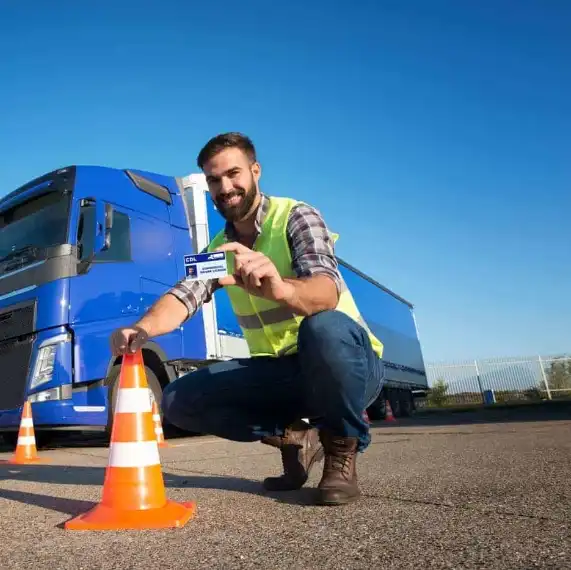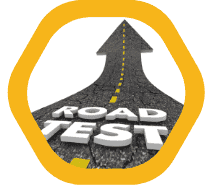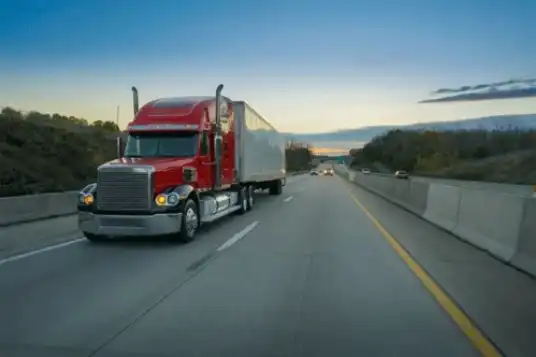- Need Any Help: +1 647-760-5505 or
- info@trubicars.ca
The Trubicars driver instruction course gives participants the opportunity to interact on multiple levels. Practice activities that have been integrated into the course include many scenario-based questions and activities that help to reinforce the material while improving retention of the information.

Getting a commercial license is different compared to other classes of license. You must apply, study, and practice with a licensed accompanying driver. You would then need to demonstrate your ability to follow traffic laws and safely handle your vehicle. Trubicars breaks down the steps needed to get a commercial license.
Note: Class A Manual Transmission Restriction:
You must complete your A Class or A Class restricted (AR) road test in a vehicle with a manual transmission. This vehicle must have at least eight forward gears, including a high-low range, or you will get a restriction on your license. If you have this restriction, you cannot operate any Class A/AR vehicle with a manual transmission throughout Ontario. You are only licensed to operate an automatic, semi-automatic, or automated-manual transmission Class A/AR vehicle.
A driver-operated clutch activated by a pedal or lever.
A driver-operated gear-shift mechanism operated by hand or foot and does not use the assistance of any automation.
This restriction will be on your driver’s license and driver’s record. It will not apply when
operating lower-class vehicles such as G or D Class.
When you feel confident with your driving experience in this vehicle, it’s time to book a road test. Commercial Road Tests are available year-round. Road test fees are paid at the time of booking the test.
If you have taken your training with a truck training school and plan to use their truck for your road test, your training school will book your road test. The training school must use the online block booking information to book a road test for you.
If you are not with a training school, you can book, cancel or reschedule a road test appointment online, by phone, or in person at a DriveTest Centre. If you cannot attend your scheduled road test, you must cancel within a minimum of 48 hours in advance, or you will lose your road test fee.
It is common to do the Commercial Road Test plus an air brake practical test on the same day. When you book the Commercial Road Test, you should specify if you want to take the test together.
Any examination fees paid in advance can be applied for up to six years from the payment date. However, any fees not used after six years are non-refundable.


Before any road test, ensure you study the Official MTO Handbook and the operating manual for the type of vehicle you are using for the road test. Practice at different locations, at a variety of times of day, and in different driving conditions, including driving on highways and reversing your vehicle.
Ensure you bring to your commercial class road test the vehicle that meets the following requirements:
Bring a truck/tractor combination where the trailer exceeds a total gross weight of 4,600 kilograms (10,000 lb) and an air brake system on both the truck/tractor and trailer.
If your vehicle does not meet the requirements for a full A-Class, you may either:
Reschedule your road test and pay an additional fee or take your current road test with the knowledge you will receive a restricted A Class license (condition R) or A Class manual transmission restriction, but not a Class A license.
This is a truck/tractor and a trailer combination when the trailer exceeds a total gross weight of 4,600 kilograms (10,000 lb), and a trailer without air brakes.
This is for a school bus having a seating
capacity of more than 24 passengers.
This is for a school bus having a seating
capacity of more than 24 passengers.
This is for a truck with a registered gross weight exceeding 11,000 kilograms, or 24,000 lb, or any truck or combination exceeding 11,000 kilograms, registered gross weight provided the towed vehicle is not over 4,600 kilograms or 10,000 lb.
This is for a bus or full-size van that has a seating capacity for ten or more passengers but no more than 24 passengers.
A bus or full-size van with a seating capacity for ten or more passengers but not more than 24 passengers and ambulances.
This is for a vehicle equipped with an air brake system.

You must arrive 30 minutes early to complete the check-in procedures and ensure you have each of the pre-test requirements listed below.
Once you arrive for your test, park your vehicle in a safe location and check-in for your test at the Front Desk or Counter A. Checking in with an agent is required to avoid delays or cancellation of your road test.
After you check in, return to your vehicle or travel to the offsite testing location, if required, and wait for the driver examiner. If you are completing a road test at a DriveTest Centre and the Driver Examiner does not arrive at your vehicle within 30 minutes, please return to the building and enquire. If you are completing a road test at an offsite location and your Driver Examiner does not arrive at your vehicle within 30 minutes of your test time, please call the DriveTest Centre to speak to a Customer Service Agent.
No one other than the examiner is allowed in the vehicle during the road test. Passengers wait in a designated safe area.
If you fail to meet the pre-test requirements listed below, your road test is canceled, and you will lose 50% of your pre-paid road test fee.
For a full A Class road test only – before the road test, the mandatory entry-level training must be completed and recorded on your driver’s record.
The manual transmission must consist of at least eight forward gears with a high-low range.
Your vehicle must be working correctly and must not have any major defects as listed under Regulation 199/07.
Your vehicle must have the required valid vehicle inspection sticker(s), annual or semi-annual, including if it is a rental vehicle.
You must have a valid daily inspection report and schedule completed for your vehicle.
You must book the correct class for the test.
Using protective headgear or eyewear, a chart of brake adjustment limits and
a means of marking the pushrod, such as chalk or something similar, are recommended
but not mandatory.
The DriveTest Centres do not provide vehicles to use for road tests. The vehicle you use for your road test can be owned, borrowed, or rented and must be insured. It does not need to belong to a driving school. The vehicle includes the trailer if it is for the test you are taking. The trailer should be empty.
Ensure you get home after the road test if you are unsuccessful.
Before the road test, the examiner will explain the road test. They are not allowed to provide advice during the road test. The examiner will provide directions, such as stop, turn left, and turn right, and none of the instructions from the examiner will involve anything illegal. If you have any questions, please ask them before the test begins..
Refer to the Official MTO Handbook for further details
about your road test

The air brake practical test is completed in a parking lot and will take approximately 30 minutes.
If you completed an MTO-approved air brake endorsement course, you must visit a DriveTest Centre within six months of completion to add the Z endorsement to your license.
There are two versions of the practical test, depending on the license class you already hold and are attempting. If you are pursuing the Class AZ, you will be required to complete testing that includes the trailer air brake system. Your test does not include the trailer air brake system for all other license classes.
Refer to the Official MTO Air Brake Handbook for more information.
If you are unsuccessful after completing the Air Brake practical test, you will be unable to proceed with your
commercial road test.
As part of your commercial class road test, you will need to complete the following tests:
You will be requested to inspect six randomly generated items from the schedule, including how to demonstrate and describe how you inspect each item. You will also explain any potential defect(s) and describe what action should be taken upon identifying the defect.
During the in-cab check portion of the test, identify and touch all items listed in the Official MTO Handbook. You need to demonstrate and describe how each item is inspected.
During the in-cab portion, you do not have to explain any potential defect(s) or describe what action you would need upon identifying a minor or major defect.
During the test, you demonstrate your ability to uncouple and couple a truck/tractor and trailer. Refer to the Official MTO Handbook for further details.
During the on-road portion of the test, you must drive smoothly and safely in different traffic situations, including left and right turns, intersections, lane changes, curves, expressway driving, and a roadside stop/start.
During the test, you must obey all traffic signs, signals, and laws, drive safely and responsibly, and wear your seat belt.
During the test, you will perform one backing maneuver, either a 90-degree alley dock to the driver’s side, an offset left, or an offset right.
The driver examiner will exercise care to prevent injury to you, other motorists, pedestrians, or themselves. If you’re lacking the necessary skills to operate a motor vehicle safely, your test is terminated. You will be immediately disqualified and will lose your road test fee.
At the end of your test, the examiner will inform you if you were successful and will review the test with you, informing you of your strengths and weaknesses, you can refer to the back of the scoresheet for more information about the scoring of your road test.
You must be successful in all areas of the test to pass the road test and obtain a commercial driver’s license.

To successfully pass your road test, you must demonstrate your ability to safely operate your vehicle, not commit any moving violations and complete each of the road test sections, meeting the criteria outlined below:
You are allowed to make errors for 1 item.
You are allowed up to 2 errors in total for both uncoupling and coupling and must complete the coupling with no more than five pull-ups.
You are allowed up to 30 errors but must complete the backing portion in less than 10 minutes.
Once successful, go into the DriveTest Centre to receive your temporary driver’s license. This license is valid for 90 days or until your permanent driver’s license arrives in the mail.
If you are unsuccessful, you can schedule and take another test when you have improved. You must wait at least ten days between tests.
Driving a commercial vehicle is a big task but a large part of our society. If driving commercial vehicles is for you, check out the Trubicars website for more information!
Once you acquire the knowledge provided in
those tests, you are ready to pass the
test, the first time.
